Low-Input Gardening
Simplify your (market) gardening and save money for the important things in life.
Before this newsletter gets going I want to thank you, dear subscribers! I’ve launched newsletters, websites and social media pages before, I’ve even published books, but none of those experiences compares with my delight over the first subscriptions here on Substack. Thank you, thank you, thank you! There are 20 of you as I write this, including a fellow woman farmer who gave me my first paid subscription (a special hug to you!). Some of you are market gardeners, some home gardeners. I will do my best to speak to both because I am both. That said, market gardening has made me a better home gardener, so I’ll be sharing experience from there.
Housekeeping:
These newsletters are weekly and should arrive in your in-box on Friday or Saturday.
If you are a German speaker, Substack will supposedly send you a translation of this newsletter if you have an account set to German. Please let me know if that actually works.
If you are a paid subscriber, the first “Deep Dive” newsletter with a link to my eBook from 2021 about low-input market gardening will be coming next week.
Now on to the subject at hand, low-input gardening:
Less is more
It’s garden planning time in the northern hemisphere and that means retailers are pushing their wares, dreamers are filling their inspo-boards on Pinterest and seed catalogs are stacking up on my desk. Always on the look-out for new varieties, I enjoy looking through those catalogs, but my seed orders are relatively small these days. There’s a salvaged cabinet twice my size full of seeds in our basement, enough to keep me growing for years. Thanks to my own seed saving, many of them are in sloppily labelled jars or hand-folded origami envelopes. It’s like my messy desk: I rarely have to search long for something, because I know where things are.
Seed saving is a big part of “low-input gardening,” a term I started using at the beginning of my fourth season in my market garden in the Tyrolean Alps. I had been really proud of doing everything by the book in my first three years. Literally tons of compost had been spread on standardized permanent beds on a quarter of an acre, detailed crop plans supposedly managed me through the main season, expensive seeders and harvesting equipment were lined up in the shed.

The list of purchases went beyond that, of course, including biodegradable plastic for covering beds (never again) and plastic landscape “fabric” for occultation (also, never again). Also called “tarping”, occultation is an important method in no-dig and low-input gardening: covering a bed or new garden space to kill off whatever is growing. It reduces labor and the need for tillers, but most importantly it protects soil ecology.
Two hoop houses joined the fun in my third season, a rare example of a wise investment. Suffice it to say, I spent a lot of money on unnecessary and sometimes contraproductive materials and equipment. The list of tools and equipment I actually use (and love) now is much shorter:
battery-powered drill and small augur for planting
broadfork, stirrup hoe, garden rake, hay rake
light-weight wheelbarrow
trays and metal racks for seedling production
high-quality black mulch fabric with the longest UV protection I can find
row cover in two thicknesses
bamboo stakes and construction-grade wire mesh for trellising
hoses and sprinklers
A bit of the backstory: Two hard lessons
Note: If you are just interested in my recipe for low-input gardening, feel free to skip the backstory.
Despite feeling good about implementing current mainstream market gardening practices and my initial success, 2019 turned out to be a year of hard lessons. It started in May with grubs. Not just any grubs, but chafer grubs, the larvae of Melolontha melolontha, the common cockchafer. North American readers will have no idea what this beetle is, because it’s a European species.


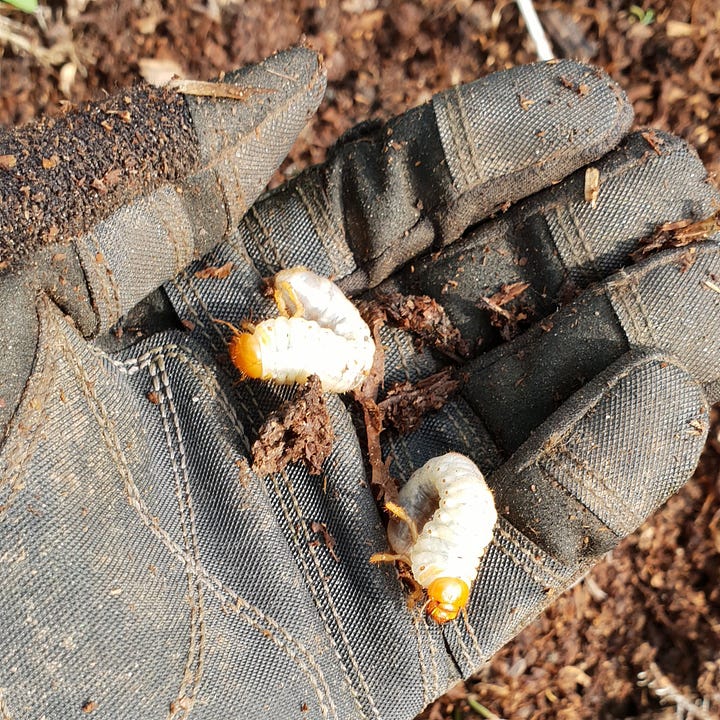
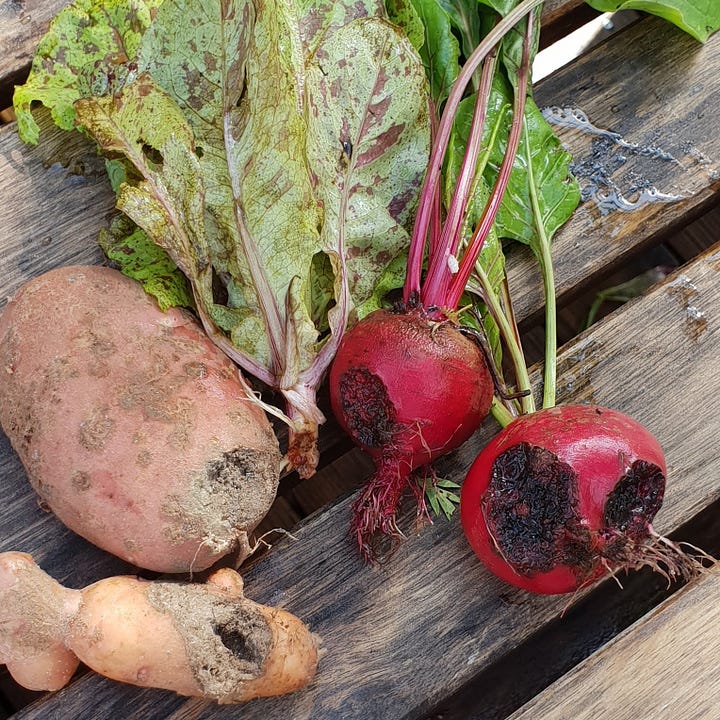
The adult beetles aren’t the problem, it’s the larvae, which can live up to five years in the soil. Every three to four years it’s a “fly-out” year, as they call it, when large numbers decide it’s time to transform into beetles. They rise out of the soil en masse, having eaten anything in their way in the process. It sounds like a bad movie, and it was, except it was real. In May of 2019, one-third of my market garden was decimated - everything from lettuce and beans to sweet corn and root veg - and I had to cancel one-third of my veg box subscriptions.
As I stood in the plot that was especially hard hit, a picture-perfect market garden with “clean” wood-chipped paths and nearly weedless beds, there came a sudden insight. Are „clean“ beds an invitation for destruction? After all, there was nothing else but my plants to eat, and these things had to eat.
That August, I learned my second lesson, when I broke a bone in my foot by stepping into a hole in a parking garage. Because I didn’t take it seriously, I broke another one two weeks later while driving, when I had to slam my foot on the clutch. That in itself was a lesson, but the real lesson was taking place while I had banished myself from the garden for four weeks to heal. My worries about the garden were more painful than my foot, because I was missing important sowing dates for fall and winter harvest. I fretted, not sure how I would have enough through November for my customers. Can the business survive when the gardener is unable to work? I feared the worst.
When I finally could go back to the field, I was greeted by a plot full of lush growth, especially in the paths.
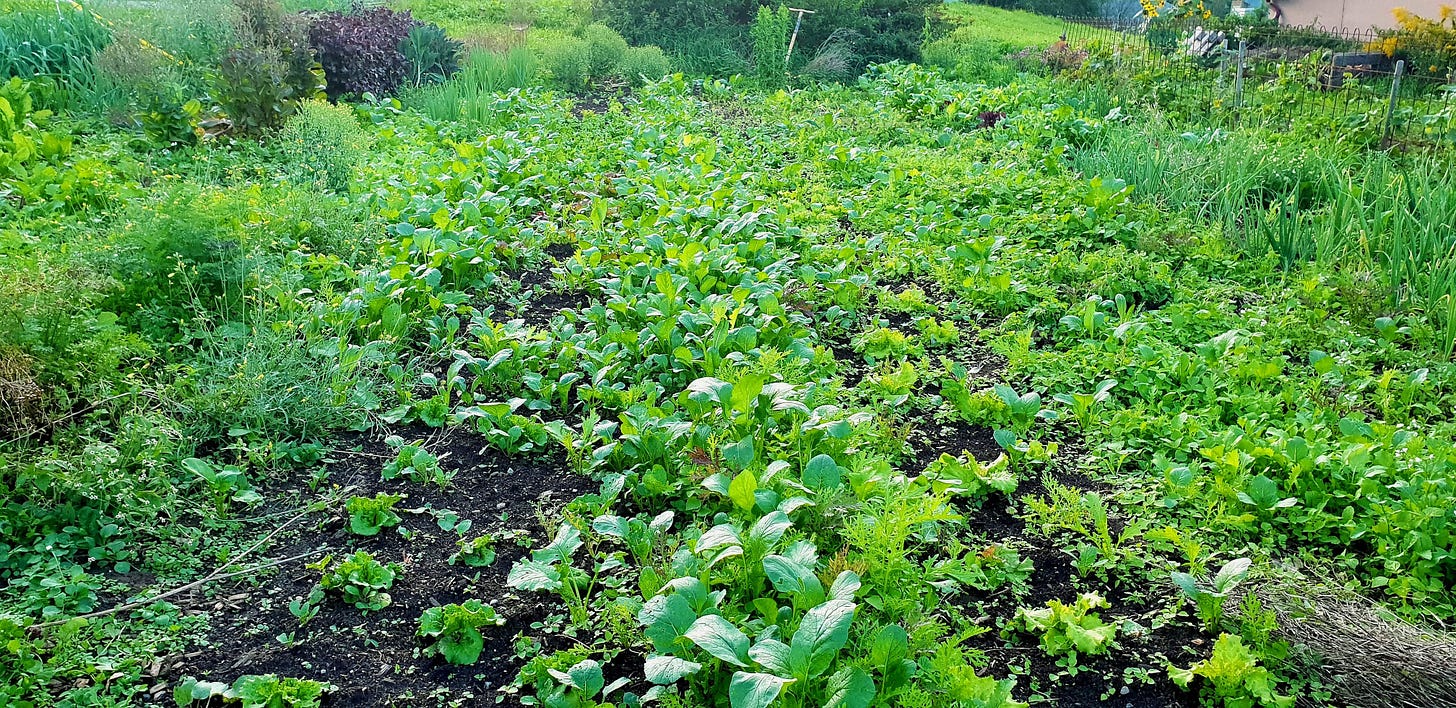
To the untrained eye, this might look like a nightmare, but it wasn’t. It was the greatest gift a garden can give: self-sown crops. I had selected plants for seed-saving in this plot and harvested the seeds in mid-summer. All of those beautiful greens had reappeared, thanks to the many rogue seeds that had escaped. In my absence, they could grow in peace. My garden had saved me.
These two lessons - the grub damage and the self-sowing garden - led to important decisions. I would have living paths from now on, i.e. let grow whatever wants to grow. Mowing would be less work than weeding and I could use the material as mulch on the spot. Most importantly, grubs would have something to munch on. The following year, with green paths, I had almost no damage, but I found grubs feasting on the roots of plantain in a path, just as they had been devouring my sweet corn the year before. It worked as I had hoped: Given the choice, grubs prefer wild plants like grasses, pointed plantain or dandelion to my veg.
Secondly, some crops, such as Asian greens, lettuce and corn salad, are ideal for a natural annual cycle. I began experimenting and let half a plot go “wild” with self-sowing crops like lettuce, kale, Asian greens, orache, bunching onions, pot marigold, borage and dill. I observed how they preferred to set up the next generation - on the same spot, a couple of feet away or scattered. I also learned which types would dominate over time, their needs for space and freedom from disturbance. It was fascinating and I was hooked. When I shared my excitement on social media, an Australian colleague farming in Japan told me about small wild sections in Japanese home gardens, where greens and shiso, among other things, are allowed to take over.
That often happens to me: I reinvent a wheel I didn’t know existed.
Low-Input Gardening in a Nutshell
This bit of backstory is only a small slice of how I came to put together a group of practices under the name of “low-input" gardening. My working definition:
a holistic approach to biointensive vegetable growing in alignment with natural self-renewing and self-generating processes that reduces inputs and labor, increases resilience and results in a better bottom line.
It involves these practices:
Minimal tillage and soil disturbance to protect the soil ecosystem and reduce weeding
Living pathways managed to reduce heat, conserve water and provide mulching material
Mulching and surface composting, whether it is straw or leaves, grass clippings or weeds I’ve pulled
Semi-permanent beds, switching out paths and beds to manage humus better
Integrated seed production and self-sowing crops
Cover cropping whenever a surface is bare, definitely in the fall if not harvesting in winter
For home gardens, it also means going back to the basics. Home and urban gardening have become a huge market for everything from fancy raised beds to designer gardening gear. I just passed by a small, unloved urban garden and almost left my card for the owners with a note to let them know I could help make the most of their investment. A tremendous amount of resources went into these raised beds (wood, metal, dirt, all with more or less high environmental costs in packaging and shipping) and they weren’t even planted with delicious winter greens!

A study comparing urban gardens with conventionally grown food published last January got quite a lot of attention in the gardening scene, because the authors claimed that the carbon footprint of food from urban gardens is six times greater than conventional agriculture1. Their conclusion initiated uproar, but the study was much more nuanced than that. Vegetables that are typically grown in heated greenhouses and shipped by air, such as tomatoes, have a smaller footprint when grown locally in urban gardens. One-fourth of individually managed gardens were also lower in their carbon footprint than conventional agriculture. The authors concluded that we can reduce climate impacts by cultivating crops that are typically high-energy (greenhouse-grown or air-freighted), by maintaining a garden for years, and by creating a circular process of turning waste (such as grass clippings and plant material) into inputs (compost, mulch, etc.).
How I grow vegetables and how I eat is good for the climate, but my reasons for gardening are much more egotistical. Greenhouses and aquaponics facilities can never achieve the variety, nutritional value and flavor profile I desire. Nothing compares to tomatoes grown in their season in healthy soil. Artificial fertilizers aren’t necessary, if we tend to healthy soil and allow the soil ecosystem to thrive. Climate-friendly (and budget-friendly) home gardens keep infrastructure to a minimum and are maintained over years to reduce the (carbon) cost of any investments. Most importantly, they garden biologically rather than chemically. Organic waste transforms into black gold on a compost heap. Electricity for lighting and heating isn’t necessary, if we’re not trying to grow on tomato seedlings in February. (Rule of thumb: 8 weeks before planting out, which for most gardeners is May.)
Growing vegetables is a relatively simple endeavor: If you’ve got soil, water, light and seeds, you’re good to go.
In other words, returning to the low-energy, low-input gardening methods of our parents and grandparents makes sense, with some tweaks. No tilling is the biggest difference between my gardening now and what I learned in my childhood on a Wisconsin farm. The second biggest difference is extending the growing season by starting frost-tolerant veggies (radishes, carrots, lettuce, peas, to name a few) as soon as the soil can be worked rather than waiting for the last frost date, and then sowing those same varieties late summer to extend harvest past the first frost.
What I’m doing in February in Zone 7b
(A note on zones: They indicate high and low temperatures. This year, my region is USDA Zone 8b, because the winter has been very mild. Still, my last frost date is early May, so tomatoes won’t get started until March.)
Preparing for transplants: Replenishing organic potting soil, setting up the sunroom for indoor seed starting
In the garden: The soil is workable in some spots, so I’ll be clearing squares for early sowings of radish, carrots and leaf lettuce (If you haven’t got anything growing, like I do, then spinach, arugula, Asian greens, beets, coriander and chervil can be on the list.)
In the cold frame: It’s full of winter greens, so I’ll be harvesting to create space for seedlings once they’ve germinated in the sunroom. If you have one, all of the list for in the garden can be sown there as soon as the soil is workable.
In the sunroom: Sowing onions, leeks, lettuce, celery, fennel, kohlrabi, cauliflower and broccoli for transplanting in March and April as well as peppers, chilis, eggplant and groundcherries for transplanting in May. It’s also a good time to start asparagus and artichokes.
In the fruit and berry garden: As soon as the soil thaws, it’s a good time to root cuttings of currants, elderberry, and other bushes. It’s also pruning time.
Early spring is time for sowing, pricking out and hardening off seedlings. Below: Sowing peppers and chilis, pricking out lettuce seedlings, hardening off, bunching onions in cells with 7-10 are easy to transplant.
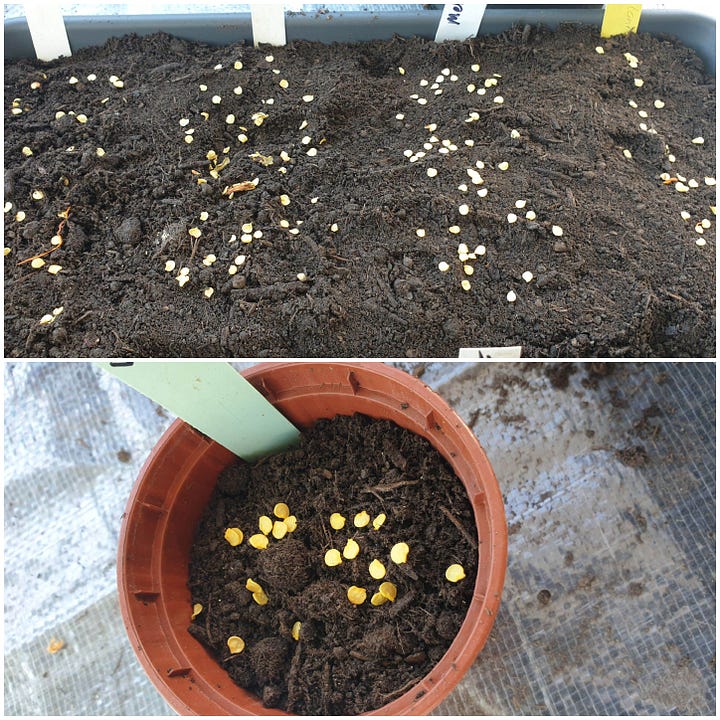
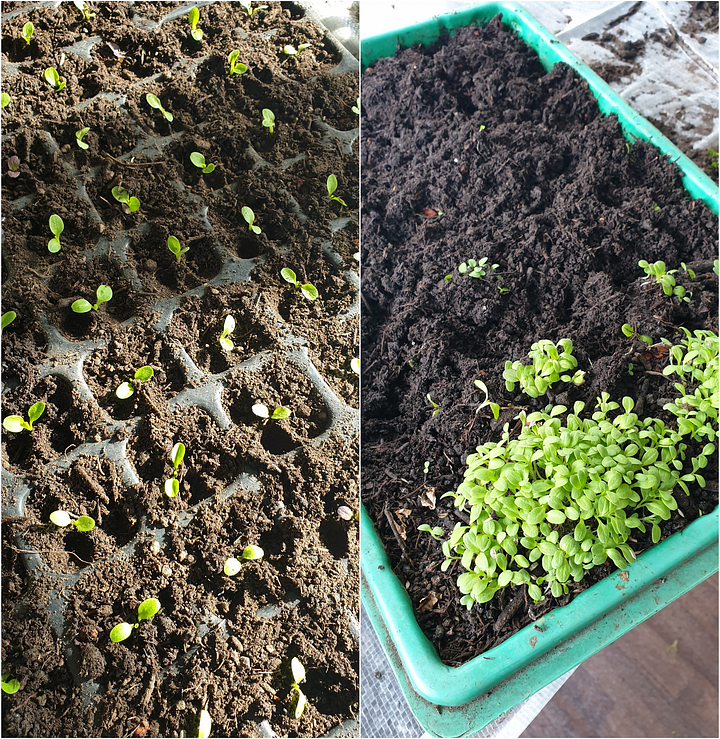

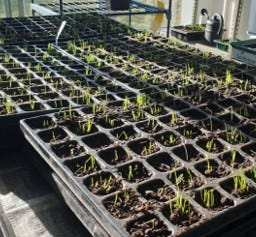
If you’ve made it this far…
Thank you for reading! Feel free to send feedback and requests. Was this newsletter too long? Would you prefer an audio file of it? Any topics you’d like covered?
Reference: Hawes, J.K., Goldstein, B.P., Newell, J.P. et al. Comparing the carbon footprints of urban and conventional agriculture. Nat Cities 1, 164–173 (2024). https://doi.org/10.1038/s44284-023-00023-3


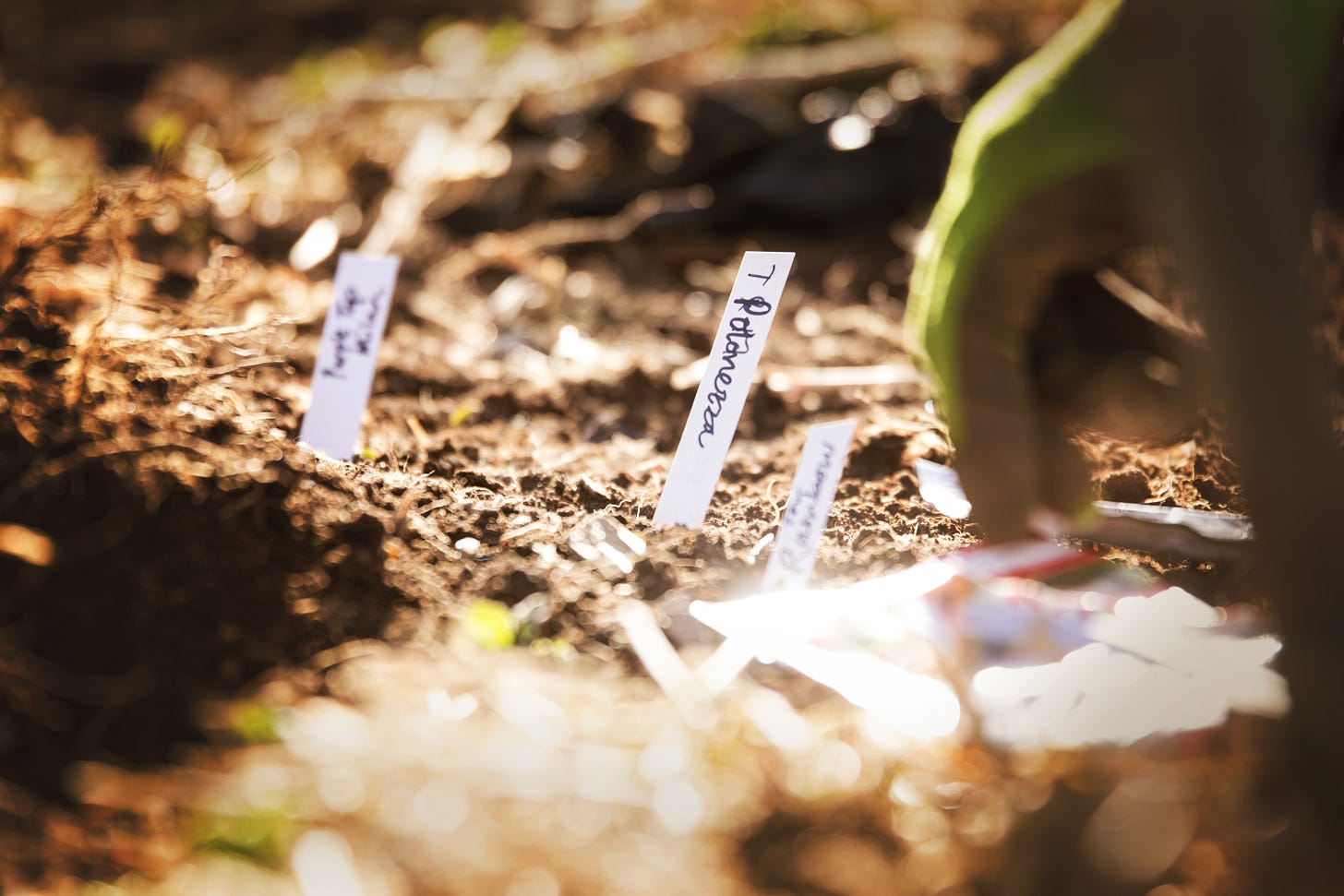
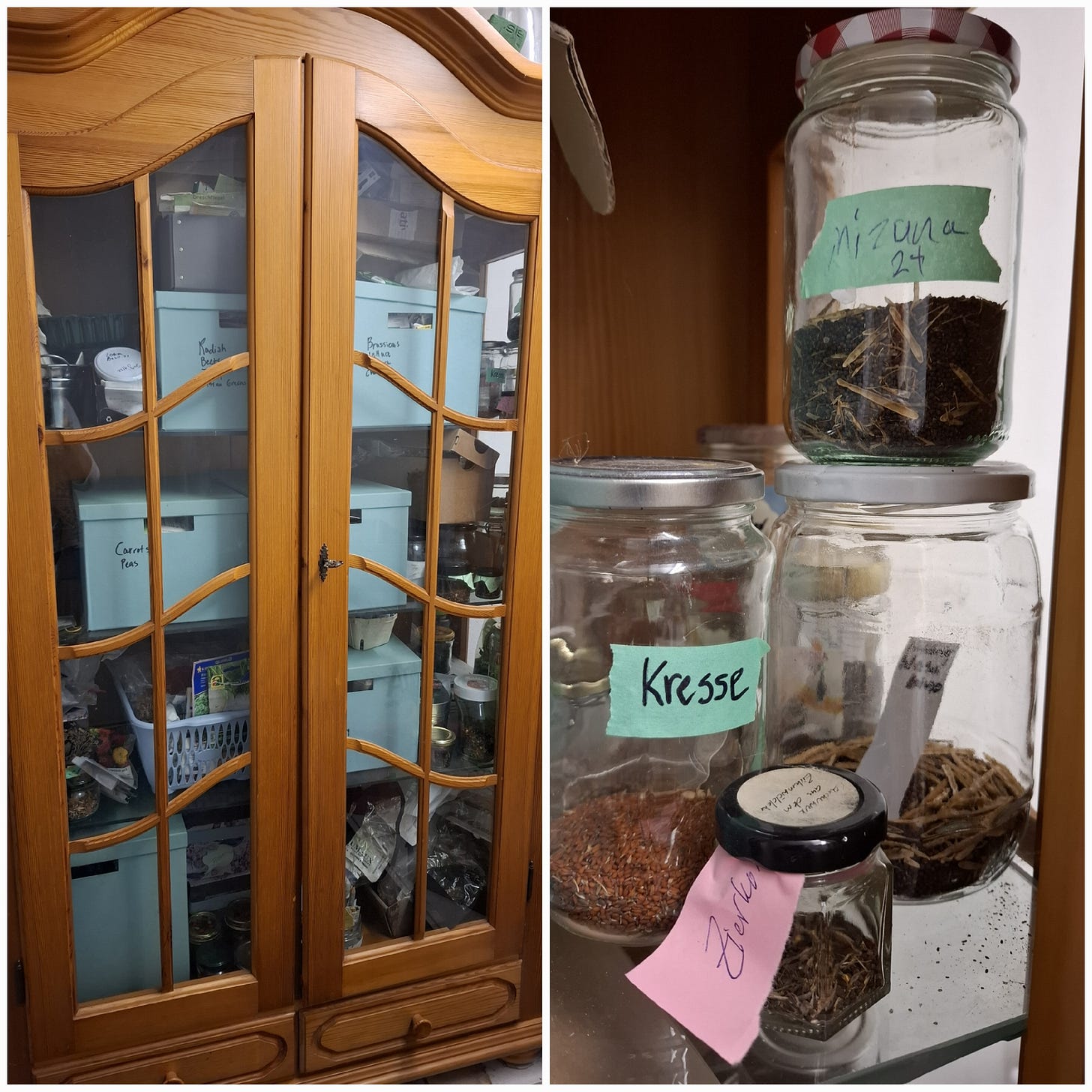
Lots of valuable insights!